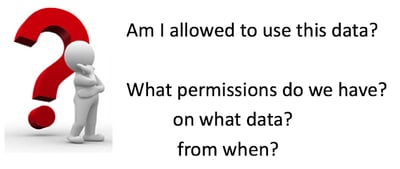This is the second part of series of blog posts on 'How the EU GDPR will affect the use of Machine Learning‘
I have the data, so I can use it? Right?
I can do what I want with that data? Right? (sure the customer won't know!)
NO. The answer is No you cannot use the data unless you have been given the permission to use it for a particular task.
The GDPR applies to all companies worldwide that process personal data of European Union (EU) citizens. This means that any company that works with information relating to EU citizens will have to comply with the requirements of the GDPR, making it the first global data protection law.

The GDPR tightens the rules for obtaining valid consent to using personal information. Having the ability to prove valid consent for using personal information is likely to be one of the biggest challenges presented by the GDPR. Organisations need to ensure they use simple language when asking for consent to collect personal data, they need to be clear about how they will use the information, and they need to understand that silence or inactivity no longer constitutes consent.

You will need to investigate the small print of all the terms and conditions that your customers have signed. Then you need to examine what data you have, how and where it was collected or generated, and then determine if I have to use this data beyond what the original intention was. If there has been no mention of using the customer data (or any part of it) for analytics, profiling, or anything vaguely related to it then you cannot use the data. This could mean that you cannot use any data for your analytics and/or machine learning. This is a major problem. No data means no analytics and no targeting the customers with special offers, etc.

Data cannot be magically produced out of nowhere and it isn't the fault of the data science team if they have no data to use.
How can you over come this major stumbling block?
The first place is to review all the T&Cs. Identify what data can be used and what data cannot be used. One approach for data that cannot be used is to update the T&Cs and get the customers to agree to them. Yes they need to explicitly agree (or not) to them. Giving them a time limit to respond is not allowed. It needs to be explicit.

Yes this will be hard work. Yes this will take time. Yes it will affect what machine learning and analytics you can perform for some time. But the sooner you can identify these area, get the T&Cs updated, get the approval of the customers, the sooner the better and ideally all of this should be done way in advance on 25th May, 2018.

In the next blog post I will look at addressing Discrimination in the data and in the machine learning models.
Click back to 'How the EU GDPR will affect the use of Machine Learning – Part 1‘ for links to all the blog posts in this series.
Start the discussion at forums.toadworld.com